SIX
SPRINGS AND RIVERS
When you drink the water, remember the spring.
CHINESE PROVERB
Before the advent of public water supplies, springs were the most valued—and sometimes only—sources of drinking water. Settlements were established around a spring that delivered high-quality water. Possibly because of the connection between living water and good health, some of the springs established a reputation for curative powers. Viktor Schauberger was convinced that the high-quality water produced by his springwater machine had healing qualities.
Springwater and mineral water are often said to be “pure,” but what is meant is “good quality.” The term pure should be reserved for H2O, or virgin water, found in Nature only in evaporated form.
THE VENERATION OF SPRINGS
Springs have long been associated with folk medicine, ritual, and religion, frequently being reported as places of power. Springs thus endowed are often called “holy wells,” which is confusing, because the word derives from the Anglo-Saxon for spring—wella (hence the expression “to well up”)—not for its modern use as a shaft excavated to reach the underground water table. The tradition of venerated springs is found in all cultures and major religions, as far back as prehistoric times. The most common association is the bestowal of supernatural qualities, and more specifically, as the abode of spirits or deities, or linked with holy figures or saints. In Britain, in most cases, a saint named at a spring had no connection with the site, but the saint’s qualities may have been associated with those previously ascribed to the spring by the pagan culture.
The waters of most sacred springs are credited with healing powers that bring about cures through immersion or drinking. In British lore the most common affliction to claim healing is infertility, followed by eye complaints. However, some springs are regarded as being so powerful—for example, Lourdes in France, or England’s only thermal spring at Bath—that they are reputed to heal many diseases. Offerings (usually coins) are made to the pools served by the springs, either as part of the locally established ritual, or as a tithe for a wish to be granted. Throughout history, such fonts have been decorated with flowers, paintings, statues, or strips of colored cloth, a tradition found all over Europe, Asia, Africa, and Central America.
Natural springs were also valued because the quality and reliability of the water flow in times of drought might make the difference between life and death. It is not difficult to see why people invested these sites with magical powers, or saw them as inhabited by a living spirit who was guardian of the waters. It is likely that many of our forebears would empathize with Schauberger’s vision of water as “the blood of the earth” when they saw the perfect nourishing liquid issuing mysteriously from the womb of the planet (see plate 11).
When the rationalism of the Enlightenment replaced the superstitions of an earlier age, some explanation had to be found for the curative powers of certain famous springs. This led, in the eighteenth century, to the birth of the spa culture. To give legitimacy to their spa water, doctors would examine any deposits left behind when they had boiled away the water, in order to identify this or that mineral as the true elixir. During the Protestant Reformation in England, and then with the decline of rural populations, many sacred springs fell into disuse until the nineteenth century, when they were rediscovered by Irish immigrants whose Celtic-based Catholicism still had strong pagan roots.
Today, with the revival of ancient rural traditions, many sacred springs are being restored in Britain and in continental Europe.
SEEPAGE SPRINGS
What is generally called a spring is actually not a true spring, but a seepage spring, which is the overflowing of surplus water from soil and rock strata of a limited depth. Rainwater that is warmer than the ground (a positive temperature gradient) soaks down until it reaches an impervious claylike layer, which channels it out as a spring at a lower level. Its movement is dictated by gravity. The temperature of the water is that of the strata from which it emerges, probably between 6°C (43°F) and 9°C (48°F). This water contains some trace elements, minerals, and dissolved salts but, generally speaking, in a narrower spectrum than that of true springs (see below). The seepage spring responds quickly to variations in precipitation, frequently drying up in a hot summer and flowing strongly after heavy rain.
TRUE SPRINGS
A true spring originates from much deeper strata (see figure 6.1). Water collects in ancient aquifers and retaining basins over many years, and the water emerging to the surface might be hundreds of years old, or even thousands in the case of certain therapeutic hot springs. Because of their vintage, such spa waters are extraordinarily rich in well-balanced minerals.
The rich waters of the Hunza Valley in Pakistan and the waters of the Caucasus Mountains, which in both instances are credited for the longevity of the local people, also originate in true springs. Their waters, augmented by rich “glacial milk,” are teeming with minerals from the action of the aggressive mountain streams eroding the surface rocks.
Rainwater penetrates the ground surface under the influence of a positive temperature gradient in a way similar to that of a seepage spring, but in this case it is drawn much deeper into the earth, helped by the increasing pressure, so that it condenses and cools to around 4°C (39°F). Being immature water, it will absorb what it can, so it removes salts from the upper layers of the ground, depositing them later as the water condenses and cools with depth. This makes the upper layers more fertile, and the salts are now available to deep-rooted trees that have the ability to metabolize them, converting them to nutrients for more shallow-rooted plants.
Downward percolating rainwater increases pressure on the groundwater body, pressing the lowest layer into rocks that are affected by geothermal heat. This causes them to expand, compressing the layers above. But the 4°C (39°F) stratum water is already at its densest and virtually incompressible at this temperature, so all it can do is push out laterally, providing the springs with their flow. This action explains how springs can emerge at such cold temperatures from high mountain peaks, where there would be insufficient local collection for gravity.
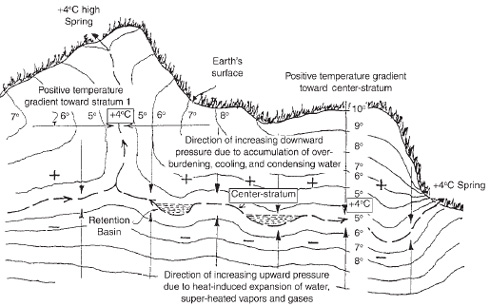
Figure 6.1. A true spring. True springs and high-altitude springs depend on the existence of the 4°C (39°F) denser water level that is called the “center stratum.” This gets squeezed between the weight of water in the rocks above, and the water strata below. At 4°C (39°F) it will compress no more and must move vertically or laterally, eventually emerging as a spring. This is why true springs are normally very cold and can issue forth on mountaintops. (Callum Coats)
Rain absorbs oxygen in its fall through the atmosphere. After it enters the ground and percolates through the soil, plant roots and organisms reduce its oxygen content. So when it eventually emerges as a true spring, the water is often oxygen deficient, though rich in carbonic acid. It is unwise to drink this water directly from the spring, because being hungry for oxygen, the water can steal it from susceptible organs, such as the stomach, causing great discomfort. If breathed directly, carbonic acid can damage the lungs. This is known by mountain folk as “damp-worm” and by miners as “choke damp” and can be fatal. However, within ten meters (about thirty feet) of the source the water has usually, through its active movement, absorbed sufficient oxygen to be quite safe to drink.
RIVERS AND HOW THEY FLOW
If we understood the importance of water for both the environment and for life, we would nurture and protect our rivers, which are Earth’s great arteries. Healthy streams and rivers are water at its most active, powerful, and playful. In our ignorance of the way in which water needs to move, we restrict rivers with embankments and other unnatural constructions. We treat rivers as sewers for waste, and we extract the energy and spirit from their form in hydropower dynamos.
For scores of thousands of years, since people started to settle on the land, our forebears were aware that their prosperity depended on the river. Because soil is quickly depleted of its nutrients by agriculture, particularly if intensive, remineralization via regular flooding was vital to obtaining good crops. This allowed the great civilizations to grow and flourish in Mesopotamia and in the valleys of the Nile, Yellow River, and Indus, to name a few.
Today’s technocrats have a need to control this apparently chaotic behavior of the natural river by steering the flow, sometimes behind high banks, and disregarding the ecosystem to the great loss of fertility of the surrounding fields. Artificial, inorganic NPK fertilizers (nitrogen, phosphorus, and potassium) cannot take the place of Nature’s remineralization; in fact, they often cause great problems by creating imbalance and pollution.
STAGES OF A RIVER
A river has three stages of life. Its youthful stage energizes the water as the steep landscape puts it through vigorous tumbling, spinning, and intense vortical movements. The immature cold water is hungry, taking up minerals as it scours the rock, cutting gullies with the suspended gravel, and chiseling the sides of the valley, especially when it is in spate. It is oxygenated in rapids and waterfalls, and put through exercises that it will use well when it matures.
When the stream leaves the steep country, the flow slows and deposits some of the heavier rock matter it carried in suspension, which will be picked up again when the flow accelerates. The water is now mature, having absorbed minerals and generative energies, and if it is prevented from excessive warming by trees on its banks, the stream water is absorbed by the banks, recharging the groundwater of the surrounding countryside (see figure 6.2). The richness of movement of the young stream is carried into the body of the meandering river. The water is creating its own form, which in turn regulates its flow.
On entering the plains, a river, left to its own devices, meanders across the flat country; where a bend twists back on itself, a shortcut will be created at flood time, leaving behind an oxbow crescent lake. It is mostly in the plains country that people try to manipulate the river, heavy with silt, by straight embankments that stop the river from spreading. If these natural floods were permitted, they might not be particularly destructive and they would remineralize the soil, making it more productive.
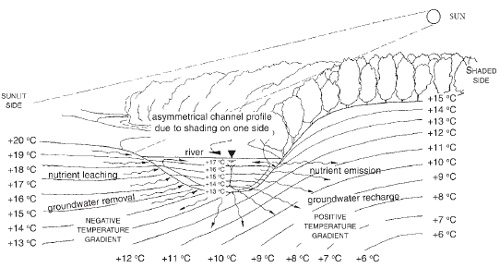
Figure 6.2. Asymmetrical river development. The bank exposed to the sun is warmed so that its groundwater leaches minerals into the stream. The shady side allows the cooler ground to absorb the mineral-rich water. (Callum Coats)
However, technical Man believes he can control Nature. The old river is now typically forced to perch sometimes fifty feet above the surrounding countryside. If the river should burst its artificial banks at this stage, flooding is often catastrophic. Without the river’s normal twisting movement and the positive temperature gradient that keeps silt in suspension, the silt is deposited, blocking the channel. Its natural path thus obstructed, the flow becomes angry and unpredictable. There are very few major rivers that are still allowed to flow naturally.
THE RIVERS ARE THE ARTERIES OF GAIA
If rivers are not allowed to operate as natural conveyors of energy and nutrients to the land through which they flow (for example, if they are disrupted by dams or artificial straightening), the fertility of the land is compromised. If we were really to take care of our rivers, protecting their banks from overheating and allowing them to flow sinuously as they want to, rather than making them follow straight lines, we would be taking important steps to give back to Nature her own power.
Do rivers have individual identity? Many people become attached to a great tree and feel its natural wisdom. Why not a great river? The tree is a column of water, spiraling upward during the day, and downward at night. A river is a horizontal column of water, spiraling and self-cleansing, bringing nourishment to the land through which it flows.
It would be good to befriend a river in your own land and experience the full span of birth, youthful joy, reaching maturity, and the serene meandering of its fullness as it nears its destination. You will learn how its energy changes with the seasons, with its rate of flow, or where a tributary joins the main stream.
It is easier to follow shorter rivers, like those of New England or parts of Europe. The identity of great rivers is also more complex and often compromised by pollution or overextraction. When you get to know a river in this way, it becomes your friend, and you will want to return and return, at different times in the year, revisiting your favorite spots.*24
HOW THE RIVER PROTECTS ITSELF
Schauberger saw water as being conceived in the cool, dark cradle of the virgin forest. As it slowly rises from the depths, water matures by absorbing minerals and trace elements on its upward path. Only when it is ripe does it emerge as a spring. In the cool, scattered light of the forest, water begins its long journey down the valley as a lively, sparkling stream.
Water, when it is alive, spirals in a convoluting motion that helps to retain its coolness and maintain its vital inner energy and health. It is thus able to convey its vibrancy to the surrounding environment. Have you noticed how refreshing and enlivening it is to sit by a healthy, bubbling stream?
Naturally flowing water seeks to protect itself from the damaging direct light of the sun. Trees and shrubs grow along the banks of streams not because people planted them, but because the energies from the flowing stream facilitated their growth there, to shade the water. When a stream is able to maintain its energies, it will rarely overflow its banks. In its natural motion, the faster it flows, the greater its carrying capacity and scouring ability, and the more it deepens its bed.
Schauberger discovered the reason for this—that in-winding, longitudinal spiral vortices form down the central axis of the current, moving alternately clockwise and counterclockwise (see figure 6.3). The nature of inwardly spiraling vortical movement is to cool, so these complex water movements constantly cool and recool the water, maintaining it at a healthy temperature. This leads to a faster, more laminar spiral flow that ejects or neutralizes undesirable substances.
As the stream gets bigger, it is less able to protect itself from light and heat. It begins to lose its vitality and health, and with this, its ability to energize the environment through which it passes.
When it ultimately becomes a broad river, the water flows slug-gishly and becomes more opaque with the increasing silt content. This, however, protects the lower strata from the heat of the sun; they remain cooler, retaining the spiral, vortical motion that is able to shift sediment of larger grain size (pebbles, gravel, and so on) from the center of the watercourse and keep down the risk of flooding. This motion also discourages the generation of harmful bacteria so that the water remains disease free.

Figure 6.3. A longitudinal vortex showing the laminar flow of a river around the central axis where the water temperature is always coldest. (Callum Coats)
TEMPERATURE GRADIENTS AND NUTRIENT SUPPLY
As we have seen, unless vegetation keeps the ground surface cooler than the falling rain, water will not easily penetrate the soil. The direction of the temperature gradient indicates the direction of movement. Energy or nutrient transfer is always from heat to cold, so a positive temperature gradient is also essential for nutrients to be able to rise up to the roots of the plants (see figures 6.4 and 6.5).
If the surface is well forested, the rainwater is warmer than the soil and penetrates to the lower strata, replenishing the groundwater body and the aquifers. The salts remain at a level where they cannot pollute the upper strata and harm those plants that are salt-sensitive. The groundwater hugs the configuration of the ground surface. The lower part of figure 6.4 shows how the salts in the ground rise near the surface, particularly on a hilltop, when part of the forest is cut down, leaving the ground exposed to sunlight.
Schauberger demonstrated that when light and air are absent well below the surface of the ground, minerals and salts are precipitated near the temperature horizon of 4°C (39°F). Warm ground will encourage evaporation of moisture near the surface, so that minerals and salts are deposited near the surface, lowering the fertility of the soil. If all the trees are removed, there will be no penetration of rainwater; the water table initially rises, due to the now uncompensated upward pressure from below described earlier, bringing up all the salts. Eventually, however, it will sink or disappear altogether without the replenishment of rainwater. Fertility can be restored only through reforestation, which brings about the reestablishment of a positive temperature gradient.
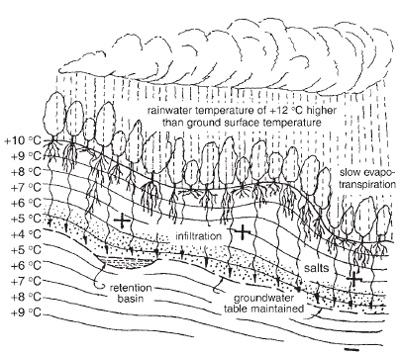
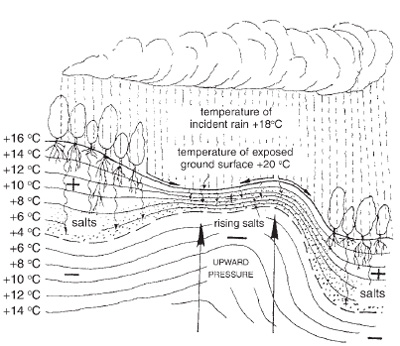
Figure 6.4. Temperature gradients. Upper: The warmer rain is absorbed into the cooler ground (positive temperature gradient), because it is protected by trees. Lower: The unprotected land surface sheds the cooler rain, causing the groundwater to rise, bringing with it unwanted salts. (Callum Coats)
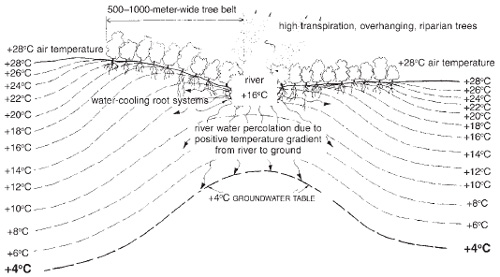
Figure 6.5. Groundwater recharge. Trees cool the ground like a refrigerator, allowing a positive gradient to draw water from the river to recharge the water table. (Callum Coats)
Replanting must be initiated with salt-tolerating trees and other primitive plants, as only these would survive under such conditions. Later, due to the cooling of the ground by the shading of the pioneer trees, rainwater can penetrate the ground, taking the salts with it. Over time, as the soil climate improves, the pioneer trees die, because the improved soil conditions don’t suit them. Other species of tree can replace them as the dynamic balance of Nature is restored.
Irrigation in hot climates aggravates the problem because ground temperatures cool during the night, allowing irrigation water to penetrate the upper, salt-containing strata. With the increase in temperature during the day, the infiltrated irrigation water with its acquired salts is drawn up, and upon exposure to light and heat the salts are deposited on the soil surface. The seriousness of the problem will vary with latitude, height, and season.
THE FORMATION OF VORTICES AND BENDS
We have seen that energy is always connected with movement. The natural movement of water is sinuous, convoluting, and vortical. Without such movement there is no polarity. Vortices, however, cannot form without the existence of polarities. Through the action of vortices come rhythms, the pulsations that act as a gateway—a breathing process that the river performs for the environment (see figure 6.6).

Figure 6.6. The energy cannon. Approaching a bend, the water forms a cooling counterclockwise longitudinal vortex (see figure 6.3), grinding sediment and releasing nutrients into the river. After the bend the vortex slows down as the water warms in the shallower riverbed, releasing nutrients. Just before a new clockwise vortex forms anticipating the next bend, it releases energy into the environment. Schauberger called this the “energy cannon.” (Callum Coats)
Schauberger invented a novel way of deflecting the flow to the center of the stream in order to form cooling longitudinal vortices.
HYDROELECTRIC POWER
Until the development of coal-fired steam engines, water wheels were an important source of power. With the arrival of electricity came an interest in water as a large-scale energy source, and dams were built to provide a higher level of kinetic energy. There are now tens of thousands of hydroelectric dams that collectively generate about 20 percent of the world’s electricity. Although dams prevent downstream flooding and provide water for irrigation, they are controversial because the associated upstream flooding destroys valuable agricultural land, ecosystems, fish migration patterns, and communities that have been established for centuries. If there is any deforestation or agriculture upstream, an artificial lake can silt up quickly, rendering the entire project virtually useless. Hydroelectricity is often seen as a desirable source of power because it does not produce CO2. However, the production of every ton of cement creates a ton of CO2, and the steel materials and transport required for construction create a whole lot more.
Large dams, which are built primarily for the political and economic interest of central government and multinational companies, can have disastrous effects on rural populations. In India, notably, large dams have displaced between 16 and 38 million people.1 The Three Gorges hydroelectric project on the Yellow River in China, completed in 2008, is particularly controversial. It has wiped out some of the most fertile land in central China. Here, 1.24 million people have had to be resettled, usually on poor-quality land. The river’s fauna has been irretrievably damaged, archaeological treasures have been submerged, and already the enormous lake is filling with silt. All this is to satisfy the rapidly expanding and energy-hungry Chinese economy. It could become a catastrophe, particularly if the enormous dam were to be damaged by an earthquake, which is not entirely unlikely in this part of China. The Yellow River’s energy dominates central China, and its interruption affects the entire country.
At present (2010), details have not yet been published on the proposed World Bank–financed River Congo dam, which is to be three times larger than Three Gorges. The health of the tropical rain forest is closely dependent on this main river system. If it is emasculated by a gigantic dam, the whole of central Africa will suffer irremediably.
The prevailing methods of hydroelectric power generation destroy the water, which is thrust down cylindrical pipes under enormous pressure. Upon leaving these, it is smashed to smithereens against steel turbine blades. The physical structure of the water is literally demolished and all the dissolved oxygen, and even some of the oxygen in the water molecule itself, is centrifuged out of the water.
This fragmented and largely oxygen-deficient water, a virtual skeleton of healthy water by the time it is forcibly expelled into the river, has disastrous consequences for fish and other aquatic life. Inevitably, certain species of fish disappear once these power stations are commissioned, and other forms of life survive with difficulty.
Smaller scale and microhydro are more environmentally friendly.2 Some have even installed fish ladders so that the energy created by the stream that nourishes the valley is not completely destroyed. Schauberger and others produced plans for channeling water spirally so that its energy is not damaged by the generators.
The water that springs from the mountains is the blood that keeps those same mountains living and is the vein that is formed within and across them.
LEONARDO DA VINCI